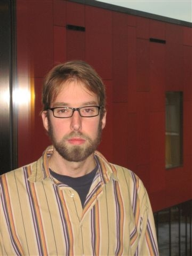Photon imaging using post-processed CMOS chips
Promotion date: 21. December 2010
Promotor: Prof. dr. Jurriaan Schmitz
Assistant promotor: Dr. Cora Salm
| Detectors for very low light levels are fabricated that can record radiation with a very high resolution. The whole system is built onto the surface of a CMOS microchip. The post-processing steps are carefully chosen to not harm the CMOS devices. The chip used is a CMOS imaging chip with charge sensitive pixels. It has been designed by the Medipix collaboration, led by CERN. The detector consists, apart from the chip, of a multiplication stage and a photocathode. Photons are converted by the photocathode. The resulting photoelectrons are multiplied by the multiplication structure after which they are recorded by the chip. The multiplication stage consists of a thin metal grid suspended above the chip surface by isolating pillars. This structure is made in the Mesa+ cleanroom. The photocathode is made of CsI and has been processed in collaboration with the Weizmann Institute of Science in Israel; the complete system was also characterized there. Other measurements were made with partners in Nikhef, Amsterdam. |
Was your thesis project application oriented?
The detector is currently only used in high-energy physics experiments, but there are always other opportunities for detecting photons. The principle is that of a multi-wire chamber on top of a specialized CMOS microchip. The multiplication mechanism is an essential part of the whole system: a controlled avalanche process that turns one detected photon into a charge signal of over a thousand electrons. The imaging chip that we use has a preamplifier in each pixel that can record such pulses. The chip is designed by CERN in Switzerland.
Was there a decisive moment that you remember very well?
Meeting the people of the Weizmann Institute of Science was. They are specialized in creating photosensitive CsI layers that are very responsive yet relatively robust. Normally, these materials are very sensitive to chemical reactions, which makes it hard to integrate them into a detector.
I met the Israeli representatives at an international workshop, asking for some help with deposition principles. This first meeting led to a collaboration that turned out to be very important.
I visited the institute two times, first by carrying out measurements on a simple device, later to test the ultimate device built on top of the CMOS chip. The results were amazing. The chip really functions as a high resolution camera for detecting single photons. The system is very small, requiring surprisingly little processing.
Did your findings lead to publications?
The final device was presented at the Vienna Conference of Instrumentation. Also articles were published in Nuclear Instruments & Methods A. Other work, about the technology, were published in technology journals such as the Journal of Micromechanics and Microengineering.
In what way did you develop as a scientist and researcher?
Now I find myself very much a technology expert, rather than a pure physicist, meaning that fabricating micro devices is my real expertise.
Building an integrated multi-wire chamber on top of a chip appeared to be a very effective and relatively low-cost way reaching high sensitivity and resolution. At the end I also had to characterize the completed system. I really enjoyed this way of working. It was a rewarding next step after working at Philips Natlab in a more specialized role.
What, in your opinion, is important for Mesa+ to stay successful?
I expect academic research will have to cope with serious cuts in budget in the near future. The toolpark currently available for research at Mesa+ still allows a lot more opportunities. Much profit can be gained by finding new combinations of technologies, for example in using proven process steps for chip fabrication in new ways. This can lead to low-cost devices if from the beginning attention is paid to compatibility parameters like temperature range and mechanical stress levels.

